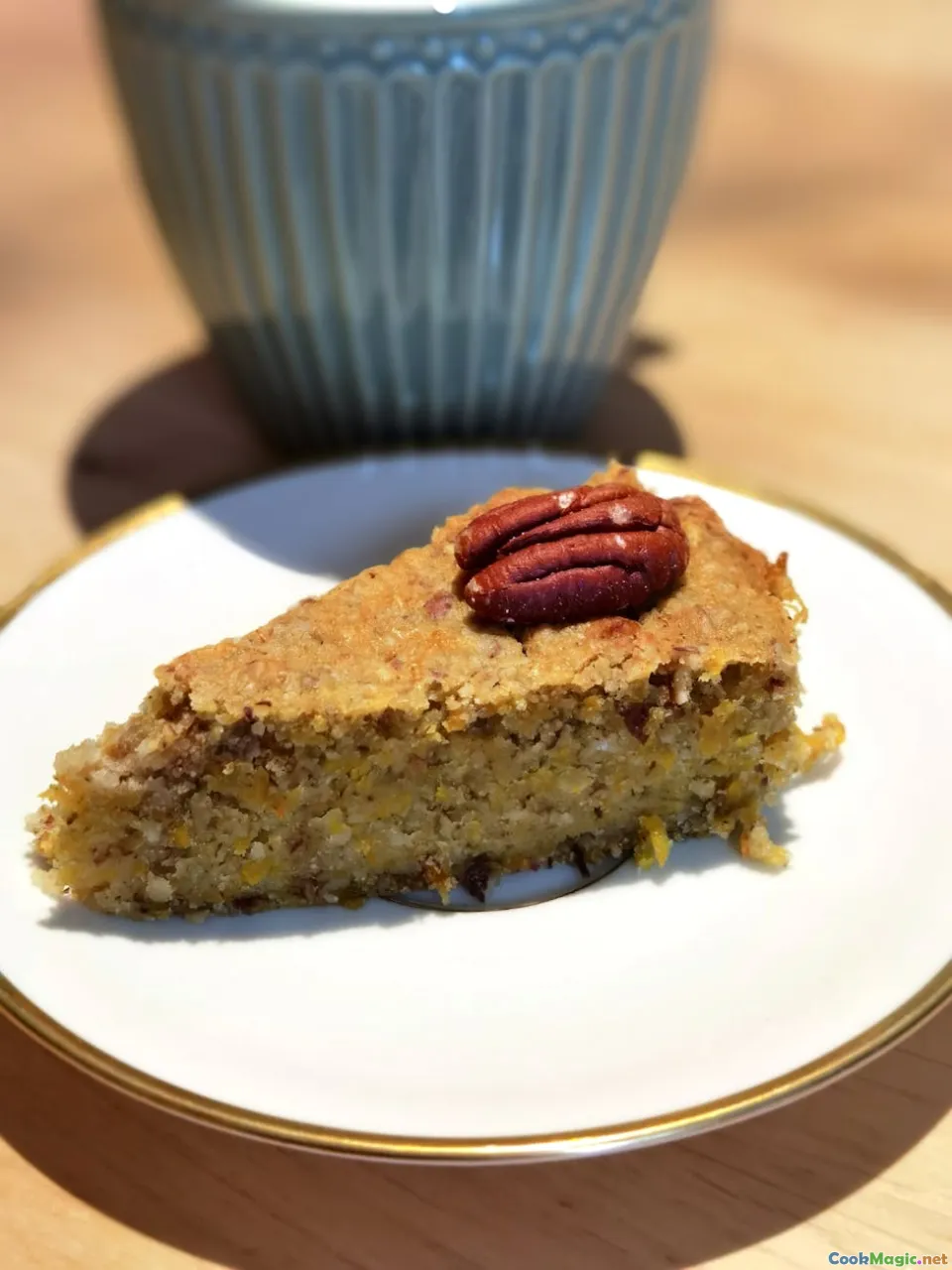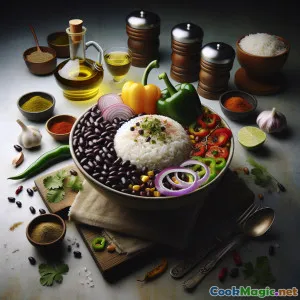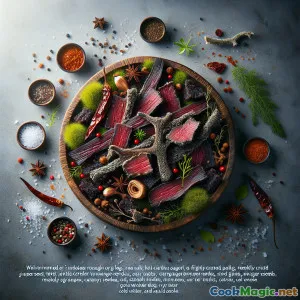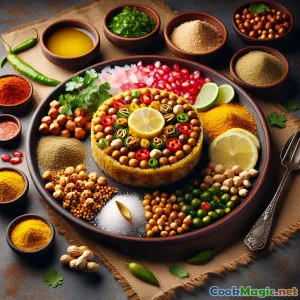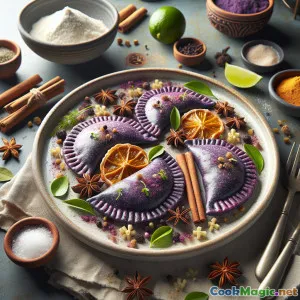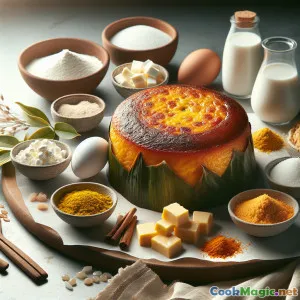
Bizcocho Guanacasteco: Herzhaftes Mais- und Käse-Kuchen
(Bizcocho Guanacasteco: Savory Corn and Cheese Cake)
(0 Bewertungen)0
81
Oktober 29, 2025
Problem melden
Zutaten
-
300 grams Masa harina (nixtamalisiertes Maismehl)
(Use fine-grind for a tender crumb)
-
200 grams Frischer Käse, fein zerbröselt
(Well-drained; avoid overly wet cheese)
-
150 grams Saure Sahne (natilla)
(Costa Rican-style natilla if available)
-
50 grams Schweineschmalz oder ungesalzene Butter, geschmolzen
(Traditional uses lard; butter works well)
-
150 ml Lauwarme Milch oder Wasser
(Add gradually until dough is soft and pliable)
-
1 large Großes Ei
(Binds and enriches; omit for denser traditional texture)
-
6 grams Backpulver
(About 1 1/2 tsp; a light modern lift)
-
6 grams feines Meersalz
(About 1 tsp; adjust to cheese saltiness)
-
20 grams Zucker
(Balances savoriness without making it sweet)
-
1 tsp Achiote (Anatto) Pulver
(For golden color and subtle earthiness)
-
1 tsp Anissamen, leicht zerstoßen
(Traditional aromatic note)
-
1 leaf Bananenblatt oder Pergamentpapier
(Line pan for aroma and easy release)
-
15 grams Geschmolzener Schmalz oder Butter, zum Bestreichen
(Glossy top and extra flavor)
(Use fine-grind for a tender crumb)
(Well-drained; avoid overly wet cheese)
(Costa Rican-style natilla if available)
(Traditional uses lard; butter works well)
(Add gradually until dough is soft and pliable)
(Binds and enriches; omit for denser traditional texture)
(About 1 1/2 tsp; a light modern lift)
(About 1 tsp; adjust to cheese saltiness)
(Balances savoriness without making it sweet)
(For golden color and subtle earthiness)
(Traditional aromatic note)
(Line pan for aroma and easy release)
(Glossy top and extra flavor)
Nährwerte
- Portionen: 10
- Portionsgröße: 1 wedge (90g)
- Calories: 255 kcal
- Carbohydrates: 0 g
- Protein: 7 g
- Fat: 12 g
- Fiber: 3 g
- Sugar: 3 g
- Sodium: 380 mg
- Cholesterol: 40 mg
- Calcium: 140 mg
- Iron: 1.4 mg
Anweisungen
-
1 - Prep pan and oven:
Preheat oven to 190°C/375°F. Line an 8-inch (20 cm) round or square pan with banana leaf (briefly passed over a flame to soften) or parchment. Lightly grease.
-
2 - Combine Dry Ingredients:
In a large bowl, whisk masa harina, salt, baking powder, sugar, achiote, and anise until evenly tinted and aromatic.
-
3 - Add fat and some cheese:
Pour in melted lard/butter and rub into the masa until sandy. Fold in two-thirds of the crumbled queso fresco.
-
4 - Bind the dough:
Whisk sour cream with warm milk (and the egg, if using). Add gradually, mixing by hand until a soft, pliable dough forms that doesn’t crack when pressed. You may not need all the liquid.
-
5 - Rest to hydrate:
Let dough sit 5 minutes so the masa fully hydrates. If stiff, knead in a splash more warm milk or water.
-
6 - Shape in pan:
Press dough evenly into the prepared pan to about 2–3 cm thick. Dimple the surface with fingertips and scatter the remaining queso fresco on top.
-
7 - Brush and score:
Brush the top with melted fat. Lightly score 10 wedges or squares to guide slicing and promote even baking.
-
8 - Bake:
Bake 28–32 minutes until deep golden at the edges, the center feels set, and a tester comes out with a few moist crumbs.
-
9 - Cool briefly:
Cool 10 minutes in the pan, then lift out using the liner. Cooling slightly helps slices hold together while staying tender.
-
10 - Serve:
Cut along the score marks and serve warm or at room temperature with coffee, horchata, or fresh cheese and natilla on the side.
Preheat oven to 190°C/375°F. Line an 8-inch (20 cm) round or square pan with banana leaf (briefly passed over a flame to soften) or parchment. Lightly grease.
In a large bowl, whisk masa harina, salt, baking powder, sugar, achiote, and anise until evenly tinted and aromatic.
Pour in melted lard/butter and rub into the masa until sandy. Fold in two-thirds of the crumbled queso fresco.
Whisk sour cream with warm milk (and the egg, if using). Add gradually, mixing by hand until a soft, pliable dough forms that doesn’t crack when pressed. You may not need all the liquid.
Let dough sit 5 minutes so the masa fully hydrates. If stiff, knead in a splash more warm milk or water.
Press dough evenly into the prepared pan to about 2–3 cm thick. Dimple the surface with fingertips and scatter the remaining queso fresco on top.
Brush the top with melted fat. Lightly score 10 wedges or squares to guide slicing and promote even baking.
Bake 28–32 minutes until deep golden at the edges, the center feels set, and a tester comes out with a few moist crumbs.
Cool 10 minutes in the pan, then lift out using the liner. Cooling slightly helps slices hold together while staying tender.
Cut along the score marks and serve warm or at room temperature with coffee, horchata, or fresh cheese and natilla on the side.
Mehr über: Bizcocho Guanacasteco: Herzhaftes Mais- und Käse-Kuchen
What is Bizcocho Guanacasteco?
Bizcocho Guanacasteco is a rustic, savory bake from Costa Rica’s northwestern Guanacaste province, where corn is the beating heart of the table. In this homey rendition, nixtamalized corn flour (masa harina) is enriched with queso fresco, natilla (sour cream), fragrant achiote, and the whisper of anise. The result is golden, crumbly, and tender—a comforting companion to afternoon coffee or a simple breakfast with fresh cheese.
Flavor and Texture
Unlike sweet cake, this bizcocho is a savory, corn-forward bake with subtle dairy richness. Achiote gives it a warm color and earthy aroma, while anise adds a traditional hint of licorice. The texture is pleasantly dense yet moist when properly hydrated, with pockets of melted, salty cheese that keep every bite interesting.
Ingredient Spotlight
- Masa harina: Choose fine-grind, nixtamalized corn flour (not cornmeal). It hydrates differently, yielding the authentic supple crumb.
- Queso fresco: Crumble finely and drain well to avoid sogginess. Its saltiness anchors the flavor.
- Natilla (sour cream): Softens the masa and adds tang. Plain full-fat sour cream is a good stand-in.
- Achiote (annatto): A natural dye and seasoning beloved in Guanacaste. Powder is convenient; paste or oil also works.
- Anise seeds: Lightly crushed for a gentle, aromatic lift. Optional but traditional.
Technique Notes for Success
- Hydration is everything: Masa harina absorbs liquid gradually. Add warm milk/water in stages until the dough feels soft and pliable, not sticky. If the surface cracks when pressed, it needs more moisture or a brief rest.
- Rest time: A short 5-minute rest allows the masa to hydrate, preventing a dry, crumbly bake.
- Fat choice: Lard gives classic depth; butter is delicious in a more dairy-forward way.
- Pan prep: Banana leaf lining adds perfume and an authentic look. If unavailable, parchment works perfectly.
- Cheese strategy: Fold most cheese into the dough for even savoriness and sprinkle some on top for a bronzed, spotty crust.
Substitutions and Variations
- Dairy-free: Replace sour cream with unsweetened coconut yogurt and use a firm plant-based cheese; opt for oil or plant-based butter.
- Egg-free: Omit the egg and add 1–2 tablespoons more sour cream or milk for cohesion.
- Spicing: Swap anise for fennel seed, or add a pinch of ground black pepper or oregano for a herbaceous note.
- Shape: Bake as a round cake and cut into wedges, press into a square for tidy bars, or shape small individual disks for snackable bites.
Serving and Pairings
- Coffee time: Serve warm with café chorreado (Costa Rican drip coffee).
- Savory sides: Fresh slices of queso blanco, a dollop of natilla, or quick-pickled onions brighten the richness.
- Breakfast: Pair with scrambled eggs and a ripe plantain for a simple, satisfying plate.
Make-Ahead, Storage, and Reheating
- Store: Keep covered at room temperature up to 24 hours or refrigerated up to 4 days.
- Reheat: Warm slices at 170°C/340°F for 8–10 minutes or on a dry skillet over medium-low heat until edges regain their gentle crisp.
- Freeze: Wrap wedges tightly; freeze up to 2 months. Reheat from frozen, adding a few extra minutes.
Cultural Context
Guanacaste’s culinary identity is grounded in corn, a legacy of pre-Columbian tradition and rural ingenuity. Bizcochos appear at family gatherings, neighborhood bakeries, and roadside sodas, often echoing the flavors of rosquillas and tanelas—other beloved corn-based treats. While every household has its own recipe, the soul of the dish remains the same: a proud celebration of maize, salt, and fire.
Troubleshooting
- Too dry or crumbly: Add warm liquid 1 tablespoon at a time, gently kneading. Next time, rest longer after mixing.
- Too dense: A touch more baking powder (if you’re using it) and careful not to compress the dough too firmly in the pan.
- Greasy top: Brush lightly with fat—just enough to sheen the surface.
Why This Version Works
This recipe balances tradition and home-kitchen practicality. Achiote and anise offer unmistakable Guanacaste character; natilla and a rest period ensure moisture; and the optional egg and baking powder provide a modern, forgiving lift. The method is streamlined, the ingredients are accessible, and the outcome is reliably golden, savory, and deeply comforting.
Enjoy Bizcocho Guanacasteco as Costa Ricans do: unpretentiously, generously sliced, and always better when shared.

